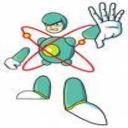Yahoo Answers is shutting down on May 4th, 2021 (Eastern Time) and the Yahoo Answers website is now in read-only mode. There will be no changes to other Yahoo properties or services, or your Yahoo account. You can find more information about the Yahoo Answers shutdown and how to download your data on this help page.
Trending News
PHYSICS HELP! (Will award best answer!)?
A 150 kg mass hangs from the end of a 7.00 m -long boom (rod) which has a mass of 65.0 kg. The boom is kept in position by a restraining cable attached 3/4 of the way
along it.
(a) Draw a free-body diagram of the boom
indicating all of the forces acting on it in
their correct locations.
(b) What is the magnitude of the tension in
the cable?
(c) What is the magnitude and direction of
the force of the hinge on the boom?
Please explain how you got the answers!

3 Answers
- Anonymous3 years agoFavorite Answer
Part a)
The forces acting on the boom are its own weight (Mg) originating from the center of mass
at half its length. The weight (mg) also acts on it together with the tension and also the
hinge has a counterforce. These can all be separated into components and unfortunately
I have no possibility to provide a picture.
Part b)
Torque: τ = rF
We can choose the hinge as the reference and balance torques about that point.
Sum of all torques is zero since the boom is held in equilibrium:
Let clockwise be the positive direction of torque, ∑τ+ = 0 =>
(½L)Mgcos50° + (L)mgcos50° – (¾L)Tsin70° = 0
The boom's length L can be crossed on both sides and won't be needed anymore.
So this rearranges to:
gcos50°(½M+m) = ¾Tsin70°
T = 4gcos50°(½M+m) / 3sin70°
Acceleration of gravity g=9.8m/s² and you also have M=65kg and m=150kg. Plug in and calculate:
T = 1631 N
(≈ 1.6 kN to two significant figures)
Part c)
The force of the hinge countering the forces from the cable, mass and boom whose components
are directed along the boom.
Fhinge = gsin50°(M+m) + Tcos70°
Fhinge = 2172 N
or 2.2 kN to two significant figures, directed at 50degrees, upwards along the boom
- electron1Lv 73 years ago
To determine the tension in the cable, let’s do a torque problem. Let the pivot point be at the hinge. The tension in the cable produces counter clockwise torque. The weights of the box and the boom produce clockwise torque.
¾ * 7 = 5.25 meter
Counter clockwise torque = T * 5.25 * sin 70
Clockwise torque = 150 * 9.8 * 7 *cos 50 = 10,290 * cos 50
Clockwise torque = 65 * 9.8 * 3.5 * cos 50 = 2,229.5 * cos 50
Total clockwise torque = 12,519.5 * cos 50
T * 5.25 * sin 70 = 12,519.5 * cos 50
T = 12,519.5 * cos 50 ÷ (5.25 * sin 70) = 2384⅔ * cos 50 ÷ sin 70
This is approximately 1631 N.
- ?Lv 73 years ago
cos 50° = 0.643
((65*7/2+150*7)*cos 50°)*g = (Ty*7*3/4*cos 50)
Ty = (65*7/2+150*7)*g*4/21 = 243.33 g N
T = Ty/(sen (180-(90+70)) = 243.33/0.342*g = 711.5*g N (≈ 6977 N)
Fy = m*g = (150+65)*g N
Fx = T*cos 20°= 6977*0.94 = 6558 N



